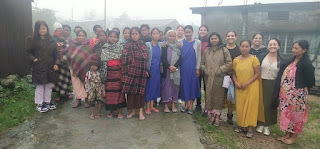Post 5: First field work in India!
After three weeks in Meghalaya, we were sent on field visits! Considering that one of the main priorities of the Rescue Mission is to decrease maternal mortality rates in the state of Meghalaya, the objective of the fieldwork was to understand some of the factors that affect maternal health. In this sense, we designed semi-structured interviews to learn how women behave during pregnancy, particularly during their antenatal care and delivery. Also, to understand their decisions regarding family planning and birth spacing. And at last, to find out how the different actors within the health system work together to support women and decrease the high maternal mortality rates. We had just four days to identify the interviewees' main actors, prepare the questionnaire and arrange the logistics. The night before, we finished everything; however, we could not pilot our questionnaire due to the short time. We adjusted some of the questions during the field visits, but I believe a pilot before the fieldwork helps to improve and be more efficient during the visits.
We split into two groups to perform the fieldwork from the 14th to the 17th of June. One visited Nongsder and Mawkyrnot villages in the Pynursla block in the East Khasi Hills District, and the other visited Ngunraw and Rangthong villages in the Mawkyrwat block in the South West Khasi Hills District.
During the summer in Meghalaya rains a lot, but that week was the one with the heaviest rains in the last fifteen years. The road was dark and foggy, with a series of landslides. We were scared during the journey because the conditions were pretty bad, but the driver was a master, and he kept us safe until we reached our destination. We arrived at the place we stayed late in the cold and dark night, without electricity and tired. We slept, and the next day we started early to visit the community in one of the early childhood development centers.
I went to the Mawkyrwat block and interviewed front-line health workers from different villages. Within the community, we interviewed two groups of women, one group of men, three adolescents, and one Self Health Group about maternal health issues in their communities. We also talked with the Block Project Manager and the District Project Manager about their role in addressing some of the health problems in the community, how they help implement different schemes, and how they interact with the ASHAs and SHGs. Finally, the team could observe a sector meeting in Rangthong’s PHC, where the MO, ANMs, ASHAs, and trained Traditional Birth Attendants (TBAs) participated.
The experience was excellent; the community was helpful and engaged with the different questions we asked. The BPM and DPM helped a lot with the logistics, allowing us to interview as many people as possible despite the challenging weather and transportation issues. In the end, we came back to Shillong happy and safe.





Comments
Post a Comment